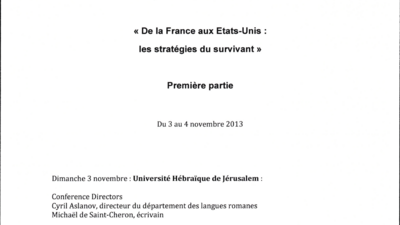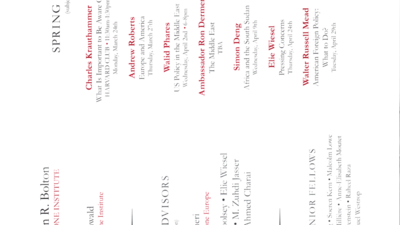Elie Wiesel Tonight on Dialogue with Doti
Title
Date
Contributor
Summary
This document is a promotional flyer announcing a television program titled "Dialogue with Doti." The program features Chapman University President Jim Doti in conversation with Elie Wiesel, a prolific author, Nobel Peace Prize recipient, and renowned Holocaust scholar. The flyer indicates that the program will air "TONIGHT AT 8:30 PM" and directs viewers to "WWW.KCET.ORG/DIALOGUEWITHDOTI" for more information. The bottom of the flyer prominently displays the logos for Chapman University and KCET, the latter celebrating "50 YEARS INSPIRING A BETTER STATE."
More Sources Like This

This document is a two-day program (November 3-4, 2013) for a conference titled "Projet Colloque Elie WIESEL: 'De la France aux Etats-Unis: les stratégies du survivant'". The event was held at the Hebrew University of Jerusalem and focused on the work of Elie Wiesel. The program lists Cyril Aslanov and Michaël de Saint-Cheron as conference directors, and details the schedule of sessions, including chairs and speakers. Presentations cover various aspects of Wiesel's oeuvre, such as translation of "Un di velt hot geshvign" to "La Nuit", biblical and Hasidic celebration, his dialogue with Mauriac and Lustiger, the question of Christianizing the Holocaust, "Les juifs du silence", and the function of insanity in his novels. Contributors include academics from institutions like Bar Ilan, Trinity University, Paris 7 – D. Diderot, and Universität Basel.

This two-page document from the Gatestone Institute outlines their "Spring Speaker Series" for 2014 and details their mission statement. Page one presents the schedule of lectures, listing prominent speakers such as Charles Krauthammer, Andrew Roberts, Walid Phares, Elie Wiesel, Walter Russell Mead, Frank Luntz, Garry Kasparov, and Mortimer Zuckerman. Each entry includes the topic, date, and sometimes the location (e.g., Harvard Club, Washington D.C.). The topics primarily revolve around US foreign policy, the Middle East, economic growth, and current geopolitical affairs. Page two provides the Gatestone Institute's mission statement, defining it as a non-partisan, non-profit international policy council and think tank focused on educating the public about global issues, advocating for democracy, human rights, and free markets. It also includes the institute's contact information and reiterates the list of distinguished speakers. The document indicates it is "BY INVITATION ONLY", functioning as a program and invitation for the event series.
of
Alex Krasheninnikow
Alex Krasheninnikow was born in Kiev, USSR in 1934. He knew that his father, a scientist, and his mother, an artist, were Jews but he had no religious education. He recalls a happy childhood with his parents in a large collective apartment shared with four Soviet families.
After the German invasion in 1941, his family was hidden in the attic of Vassily and Ina Baranovski in Darnitsa, near Kiev. Gold jewelry was exchanged for food and shelter until November 1943 when their hideout was discovered and their protectors were shot. Alex and his parents were sent by freight car to Brätz concentration camp near Schwiebus. Watchtbandguards beat them with clubs and separated men from women. Food shortages, cold barracks and arduous road building are mentioned, and the daily gymnastic regime of forced running for hours is detailed.
The Russian Army liberated the camp in January 1945 and the reunited Krasheninnikow family returned to Kiev. In July 1950, they moved to Munich illegally. In December 1950, they emigrated to Philadelphia, where Alex became a court interpreter. He refers to accounts in Russian publications that number the Babi Yar killings during 1941 – 1943 with various figures, from 30,000 to 100,000.
of
Charles Willner
Charles Willner was born in 1926, in Dombrowa, Poland into a large, religiously observant family. His father was in the cattle business and a decorated Polish Army veteran.
Charles describes anti-Jewish regulations after September 1939. In early 1940, when only 13 years old, he was sent to Pustkow labor camp and describes conditions there. In November 1940, he was held in Montelupich prison on a trumped-up charge. He was tortured and released after six weeks. While at Pustkow he was given passes by a German officer and was able to smuggle food to relatives in Dombrowa and Tarnow. He was caught and sentenced to die by German S.S., but another man was killed instead of him.
Charles stayed in Pustkow until 1942 when he was transferred to Mielec, a Heinkel-Messerschmitt airplane factory. He describes the heavy labor and surviving typhoid. He also explains why most prisoners did not try to escape from Mielec.
In 1944, prisoners were transferred to an underground salt mine then to Plaszow, near Krakow. He describes in detail his 11 weeks at Poliowa Gorka, a site of mass murders. Mounds of corpses they had to uncover and burn after their gold teeth had been extracted. He witnessed the execution of people caught crossing the border, random killings, and retaliation killings if anyone managed to escape. He describes how he survived by chance.
In late 1944, after a stop in Gross Rosen, he arrived at Oscar Schindler’s ammunition factory in Brinnlitz where he remained until May 8, 1945 when the Russians liberated the camp. He testifies to Schindler’s protection of his workers and refers to acts of sabotage. He also speaks of his own attitudes toward Germans today and his pride in the State of Israel.
After liberation in 1945 he searched for his family, encountered Polish antisemitism, including the murder of a fellow concentration camp survivor. He left Poland for Prague, then Munich. There he was united with his older brother, the only other survivor of his immediate family. With the help of Jewish agencies, the two remained in Germany. In May 1948, Charles Willner emigrated to the United States. He met his future wife, a survivor of Auschwitz, on the boat.
of
Ursula M. Heisman
Ursula M. Heisman was born in Mewe, Germany (now Gniew, Poland). Ursula grew up in Berlin and was a teenager when Hitler came to power in 1933. Her father, Isidor Hirschfeld, was a physician who served as such in the German army in World War I. He received the Iron Cross. Ursula had two older brothers. Her parents were “free thinkers” and her upbringing was an assimilated upper middle class one, with little Jewish content.
While still in high school Ursula was employed as an actress and dancer in a theater company. Ursula describes the rise of Hitler and the consequences it had for her and her family. For example, she was fired from her job as a dancer and her father could no longer practice medicine. She tells how they were made to wear the yellow star and of how her father resisted wearing it. When Ursula witnessed Kristallnacht she decided that she must leave Germany. One of her brothers, a physician, had already gone to the United States. Ursula recounts the difficulties she encountered in leaving Germany. It was only to Cuba that she was able to emigrate, and she tells of arriving in Havana, with her other brother, in 1938. Ursula recounts how she got a job as a dance teacher and that she was invited to move in with her employers, who were not Jewish, who subsequently paid $1000 to the Cuban government to obtain visas for her parents. They arrived in Cuba on the ship after the St. Louis. Ursula describes life in Havana which she enjoyed very much.
In 1945 Ursula and her parents moved to the United States, joining one brother and leaving one in Cuba, who did join them at the end of the war. She tells of resuming her career as a dancer and eventually marrying and moving to Philadelphia where she decided to open a dance school. Eventually she had three schools and a ballet company called Ballet des Jeunes which engaged the top 25 students at her schools. The company danced throughout the United States and in Europe. Ursula closes her testimony recounting a trip to Berlin she and her husband took in 1969 or 1970.
of
Malvina Herzfeld
Malvina1 Herzfeld, born in Zurich, Switzerland in 1914 describes living in Tsobut, Danzig from 1924 to 1936; moving to Holland where she married Martin Sternfeld, a German lawyer, in December, 1937; the German invasion of Holland in May 1940; the establishment of Westerbork as a transit camp for German Jewish refugees who were supported by the Dutch Jewish community and the Jewish Council. Malvina explains that her husband was arrested by the SS during a roundup of Jewish men in 1941, sent to a camp in Holland and then to Mauthausen concentration camp. She received his death certificate September 1941.
Malvina worked for the Jewish Council. She was arrested and released. Malvina and other Jews were helped or hidden by a non-Jewish Dutch neighbor. Malvina agreed to work with the Dutch underground led by Walter Suskind. She describes how her group saved Jewish children, who had been taken from their parents, from the transports. While working as a courier to the Hague and Westerbork, she tried to rescue Jewish boys. She was arrested by the SS, put into solitary confinement, and tortured. She did not talk and was sent to Auschwitz-Birkenau where she encountered Hans Totman, a Jewish war criminal who worked for the Germans. She describes arrival, selection process, living and working conditions in Birkenau.
Because she spoke German, she was taken to work as a secretary for the Oberscharführer at Budy, together with another Jewish girl. They narrowly escaped being sent to the crematorium for stealing food.
In January 1945, Malvina was forced on a death march from Auschwitz to Bergen-Belsen, where she stayed until April 1945 during a typhoid epidemic. She describes liberation by British troops, punishment of the guards, the hanging of the camp commanders, and post-liberation conditions. The British took survivors to a military camp until displaced persons camps were established. She worked for the British army as a translator and had a brief reunion with her brother who served in the British army.
Malvina could not get permission to join her brother in England. She was sent to Holland and quarantined. She stayed in Holland until 1947 and relates attempts to find out what happened to her family and her husband, and located friends from the underground. An interesting vignette details how she located the Jewish girl from Budy after the war. She emigrated to the United States in 1947.